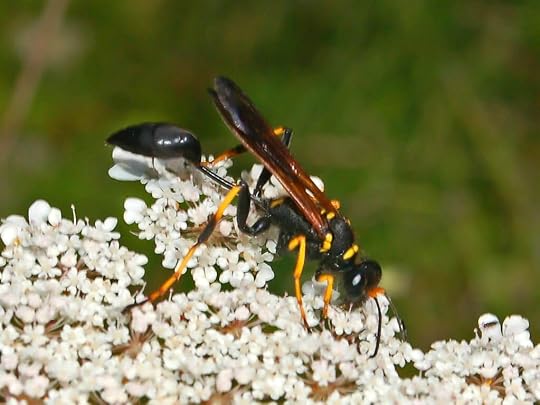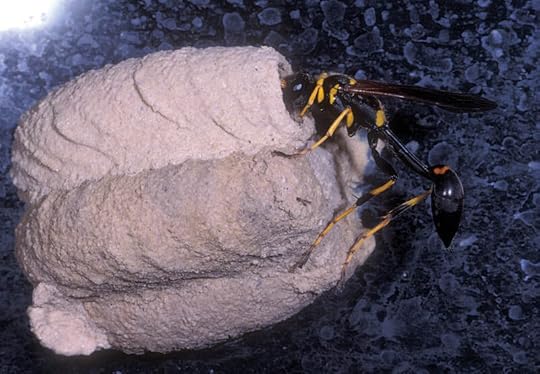My Favorite Wasp Is a Solitary Worker, Like Me
Hungary is home to all sorts of hornets and wasps, and I inevitably suffer the joys of their stings at least a half-dozen times throughout the summer while I am outside working on the house.
However, over the years, I have noticed one particular species that exhibits no aggression toward me, even when I unintentionally disturb them or their nests.
That species is known as Sceliphron caementarium—more commonly known as the yellow-legged mud dauber wasp. By Hectonichus - Own work, CC BY-SA 3.0, https://commons.wikimedia.org/w/index... Unlike the vast majority of its wasp cousins, the mud dauber lives a solitary life and spends most of its time flying back and forth from its nest, which it crafts from mud and situates under the eaves of buildings and other shaded, sheltered, and semi-sheltered spaces.
By Hectonichus - Own work, CC BY-SA 3.0, https://commons.wikimedia.org/w/index... Unlike the vast majority of its wasp cousins, the mud dauber lives a solitary life and spends most of its time flying back and forth from its nest, which it crafts from mud and situates under the eaves of buildings and other shaded, sheltered, and semi-sheltered spaces.  I first became aware of the mud dauber while I was laying bricks for one of my projects. There was a nest on the eave of the building I was working on, and the slender-bodied wasp came and went throughout the day, paying little attention to me as I built my own wall. If I happened to be too close to its nest on one of the dauber’s return flights, it simply turned around, flew off, and returned later when I was farther away from the nest.
I first became aware of the mud dauber while I was laying bricks for one of my projects. There was a nest on the eave of the building I was working on, and the slender-bodied wasp came and went throughout the day, paying little attention to me as I built my own wall. If I happened to be too close to its nest on one of the dauber’s return flights, it simply turned around, flew off, and returned later when I was farther away from the nest.
So preoccupied was the wasp with its own nest building that it showed no interest at all in my own construction efforts. After a while, I began to feel an affinity for the yellow-legged insect. We were both solitary types, working away at our given projects, content to leave the other in peace.
I later learned that mud daubers can sting people but only tend to do so in life-and-death situations. Unlike other wasps, it will generally not attack you if you knock its nest down.
Speaking of nests, I also discovered that mud daubers hunt spiders, paralyze them with venom, and then place the paralyzed and preserved but still alive arachnids into the nest, where they eventually serve as a food source for mud dauber larvae after they hatch in their own separate chamber.
During a recent renovation project, I had no choice but to knock down a dauber nest and was startled to find six paralyzed spiders alongside the developing larvae.
I must admit that I find all of that a bit "creepy" (pun intended). Nevertheless, the yellow-legged mud dauber remains my favorite wasp for two simple reasons -- it works alone and does not bother me while I am working alone.
However, over the years, I have noticed one particular species that exhibits no aggression toward me, even when I unintentionally disturb them or their nests.
That species is known as Sceliphron caementarium—more commonly known as the yellow-legged mud dauber wasp.
 By Hectonichus - Own work, CC BY-SA 3.0, https://commons.wikimedia.org/w/index... Unlike the vast majority of its wasp cousins, the mud dauber lives a solitary life and spends most of its time flying back and forth from its nest, which it crafts from mud and situates under the eaves of buildings and other shaded, sheltered, and semi-sheltered spaces.
By Hectonichus - Own work, CC BY-SA 3.0, https://commons.wikimedia.org/w/index... Unlike the vast majority of its wasp cousins, the mud dauber lives a solitary life and spends most of its time flying back and forth from its nest, which it crafts from mud and situates under the eaves of buildings and other shaded, sheltered, and semi-sheltered spaces.  I first became aware of the mud dauber while I was laying bricks for one of my projects. There was a nest on the eave of the building I was working on, and the slender-bodied wasp came and went throughout the day, paying little attention to me as I built my own wall. If I happened to be too close to its nest on one of the dauber’s return flights, it simply turned around, flew off, and returned later when I was farther away from the nest.
I first became aware of the mud dauber while I was laying bricks for one of my projects. There was a nest on the eave of the building I was working on, and the slender-bodied wasp came and went throughout the day, paying little attention to me as I built my own wall. If I happened to be too close to its nest on one of the dauber’s return flights, it simply turned around, flew off, and returned later when I was farther away from the nest. So preoccupied was the wasp with its own nest building that it showed no interest at all in my own construction efforts. After a while, I began to feel an affinity for the yellow-legged insect. We were both solitary types, working away at our given projects, content to leave the other in peace.
I later learned that mud daubers can sting people but only tend to do so in life-and-death situations. Unlike other wasps, it will generally not attack you if you knock its nest down.
Speaking of nests, I also discovered that mud daubers hunt spiders, paralyze them with venom, and then place the paralyzed and preserved but still alive arachnids into the nest, where they eventually serve as a food source for mud dauber larvae after they hatch in their own separate chamber.
During a recent renovation project, I had no choice but to knock down a dauber nest and was startled to find six paralyzed spiders alongside the developing larvae.
I must admit that I find all of that a bit "creepy" (pun intended). Nevertheless, the yellow-legged mud dauber remains my favorite wasp for two simple reasons -- it works alone and does not bother me while I am working alone.
Published on September 14, 2025 00:58
No comments have been added yet.



